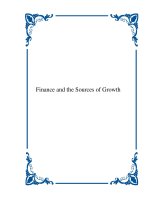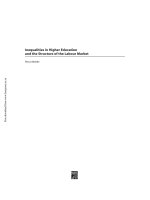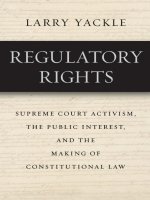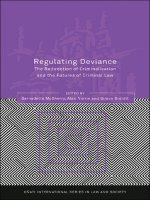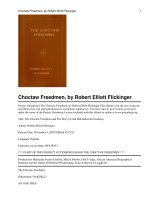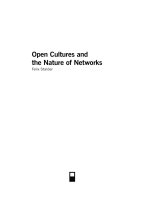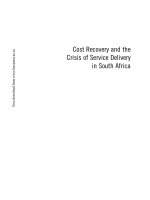- Trang chủ >>
- Sư phạm >>
- Sư phạm mầm non
Ioffes normal cone and the foundations of welfare economics An example
Bạn đang xem bản rút gọn của tài liệu. Xem và tải ngay bản đầy đủ của tài liệu tại đây (381.17 KB, 0 trang )
<span class='text_page_counter'>(1)</span>Economics Letters North-Holland. 15. 28 (1988) 15-19. IOFFE’S NORMAL An Example *. CONE AND THE FOUNDATIONS. OF WELFARE. ECONOMICS. M. Ali KHAN Unioersiry. of Illinois,. Received Accepted. 20 November 22 December. Champaign,. IL 61820, USA. 1987 1987. We announce an example of an economy with an infinite dimensional commodity space for which the extension of the second fundamental theorem of welfare economics is valid if marginal rates of substitution are formalized in terms of either the Clarke normal cone or the Ioffe normal cone but in which the former is strictly contained in the latter. This is in direct contradiction to the finite dimensional situation.. 1. Introduction In a recent paper, the author reported an extension of the so-called second fundamental theorem of welfare economics in which the marginal rates of substitution are formalized through the use of the Ioffe normal cone; see Khan (1987). In particular, it was shown that under a mild constraint qualification and modulo scalar multiples, the Ioffe normal cones to the production and the ‘no-worse-than’ sets at the respective production and consumption plans have a non-empty and non-zero intersection. If these sets are generated by differentiable functions, the Ioffe normal cones reduce to singletons and the result yields the conventional necessary conditions for a Pareto optimal allocation as in Hicks (1939), Lange (1942), Allais (1943) Samuelson (1947) and Van de Graaf (1957). If these sets are convex, the Ioffe normal cones reduce to the cones conventional in the sense of convex analysis and the result yields the statement that Pareto optimal allocations can be sustained through profit maximization by producers and expenditure minimization by consumers as in Arrow (1951) Debreu (1951, 19.54) Malinvaud (1953) and Koopmans (1957). Finally, since the Ioffe normal cone is contained in the Clarke normal cone, the result also generalizes recent work of Khan and Vohra (1987) Yun (1984) Quinzii (1986) and Cornet (1986) which in turn generalized the earlier work of Guesnerie (1975). The results in Khan (1987) are limited to an economy with a finite dimensional commodity space and were initially motivated by the consideration of an example of an economy with a production set without free disposal and for which the marginal rate of substitution at a Pareto optimal production plan, as formalized by the Clarke normal cone at that plan, is the entire dual space. It was shown that the Ioffe normal cone at such a production plan is more in keeping with our intuitive notion of a marginal rate of substitution. In this note, we present an example of an economy with an infinite dimensional commodity space that furnishes an opposite conclusion. In particular, the economy has a * This research is supported, in part, by a NSF. grant. The author is grateful for the comments Diamantaras, L. McKenzie, W. Thomson and the participants of the economic theory seminar Rochester. Errors are solely his.. 0165-1765/88/$3.50. 6 1988, Elsevier Science Publishers. B.V. (North-Holland). and questions of D. at the University of.
<span class='text_page_counter'>(2)</span> M.A. Khan / Ioffe’s normal cone, foundations of welfare economics. 16. production set without free disposal and for which the Ioffe normal cone at the Pareto optimal production plan is the entire dual space, but the Clarke normal cone is a strict subset. Intuition gets somewhat stretched in an infinite dimensional setting but the Clarke normal cone at such a production plan does not seem unreasonable. Our example underscores the unpredictability of the Ioffe normal cone in an infinite dimensional setting and is based on Treiman (1983). Section 2 reviews some basic concepts and section 3 presents the example. Section 4 is devoted to three concluding remarks.. 2. The basic concepts In this section we present the definitions of the Clarke and Ioffe cones. Since our example is set in an infinite dimensional space, we develop these definitions in the context of an arbitrary Banach space E. However, for concreteness, the reader may choose to think in terms of Euclidean n-space R” or, for that matter, in terms of R2. We begin with a tangential approximant of a set introduced by Bouligand (1932) and Severi (1930) and termed the contingent cone. It was first applied in economics by Otani and Sicilian (1977). Definition. 2.1.. { tk } of positive all k}.. The contingent cone of Y C E at y E Y is the set TK(Y, y) = {x E E; 3 a sequence numbers with tk + 0 and a sequence { xk} with xk + x such that (y + tkxk) E Y for. Definition 2.2. The Clarke tangent cone of Y c E at y E Y is the set T,( Y, y) = {x E E: For any sequence { tk } of positive numbers with t k + 0 and any sequence { yk ) with yk E Y, yk + y, there existsasequence {x”} withxk+xsuch that (yk+tkxk)e Yforallk). Definition 2.3. For any cone A C E, the polar cone A +istheset where E * is the topological duaf of E. [Note that (R”) * = R”.]. Lyme*:. (y,. x)<OforallxEA). We shall denote the polars of TK (Y, y) and T,( Y, y) by NK(Y, y) and NJ Y, y) and refer to them as the contingent normal cone and Clarke norma/ cone respectively. For more details into these definitions, see Clarke (1983) and Khan and Vohra (1987). Definition 2.4. sequence { yk}. The Ioffe normal cone to Y C E at y E Y is given by the set N,( Y, y ) = { x E E *: 3 a with yk E Y, yk +y and xk E N,(Y, yk) with xk +x}.. For details, see Ioffe (1981, 1984) and Khan (1987). The reader can check his understanding of these basic concepts by referring to the technology depicted as Y in fig. la. The contingent cone TK( Y, y) is given by the shaded cone in fig. lb, the Ioffe normal cone N,( Y, y) by the two arrows in fig. lb and the Clarke normal cone Nc( Y, y) by the cone enclosed by these arrows. The Clarke tangent cone T,( Y, y) is the set of all vectors making an obtuse angle with elements of N,( Y, y) and the contingent normal cone NK( Y, y) is zero. We conclude this subsection by mentioning a result due to Cornet that brings out the central position of the contingent cone. Let Y be a non-empty closed set in R”. Then Tc( Y, y) = {x E R”: For all sequences Theorem. with yk E Y, yk + y, there exists xk E T,(Y, yk) with xk + x}. Proof.. See Borwein and Strojwas (1985, Theorem 4.1).. { yh }.
<span class='text_page_counter'>(3)</span> M.A. Khan / loffe’s normal cone, foundations of welfare economics 3.. 17. The example. We work in c,,, the space of sequences of real numbers converging to zero and endowed with the supremum norm. This is a Banach space with I, as its dual [see, for example, Dunford and Schwartz (1957) for details and elementary properties]. For any x, y in cO, let x >y denote x, 2y, for all coordinates i in N, the space of positive integers. Let ce+ = {x E c,,: x, 2 0 for all i in N }. I, + has an analogous meaning. The economy we present consists of c0 as the commodity space and two agents, a producer with production set Y c c0 and a consumer with 0 E cc, as the endowment, X = {x E cO: x2 2 0, x3 2 0} as the consumption set and 2 as the preference relation on X. The production set Y is given by. {tw: t20) u( u Am), l7lEN. where. [a, h).A=. {tu:. z = (1, -L,O,O,. t~[a, . ..)Ec~.. b)cR. and UEA}, w=(o,o,. 1,. and e, is a vector in c0 with all coordinates. -l,O,. . ..)EcO.. x,=. zero except for the ith coordinate. b Fig. 1. -e,+,,. HEN, which is unity..
<span class='text_page_counter'>(4)</span> M.A.Khan / Ioffe’s normalcone,foundations. 18. of welfare economics. Note that Y is a technology capable of producing two outputs, the first and the third, and through the use of a countable number of inputs. More specifically, it consists of the technique w which can be operated at any non-zero level and the technique z which can be operated at any level l/m, m a positive integer. There is also the option of joint production of the first and third commodities but in this case ‘small’ units of the third commodity require specialized inputs given by the elements of x,. Lemma 3.1.. Y is a non-empty,. closed subset of co such that (i) Y n co+ = {0},(ii) Y 0) = { tw: t 2 0}, (v) N,(Y, 0) = I,.. n (- Y) = {0},. (iii) Tk( y, l/mz) = {0}, (iv) r,(Y,. Note that (i) formalizes the impossibility of producing something from nothing and (ii) the property of ‘irreversibility’. Furthermore, Y is not convex and does not satisfy the property of ‘free disposal’, i.e., for any y E Y, y - (c,,) c Y. For details of these properties, see the standard reference, Debreu (1959). of Lemma 3.1. Non-emptiness of Y is trivial and properties (i) and (ii) require routine computations. The shortest, though not necessarily the most transparent, proof of closedness, properties (iii) and (iv) can be had by the observation that Y satisfies all the assumptions required for Counterexample 3.1 in Treiman (1983). (v) follows from Definition 2.4 and (iii). Q.E.D.. Proof. Now observe that (0, 0) E (cO x co) is a Pareto optimal allocation of our two-agent economy. If not, there exists y E Y, y # 0, such that y 2 0. But this contradicts Lemma 3.1(i). Now the ‘no worse than’ set at 0 is given by cợ Furthermore, N&cơ, 0) = -fi+. Since NC(Y, 0) = (r,(Y, O))+= {p E I,: (p, w) 5 0}, we obtain. e=N,(Y, 0) n (-&(co+,. O))={~E/~:. p,>O(iEN). and. p3<p4}.. On the other hand,. y=N,(y,. 0) n (-MC,+,. 0))=. {pEl,:. p,>O(iEN)}.. The fact that c!c~, L'#Y is forbidden by the principal result in the finite dimensional setup in Khan (1987).. 4. Concluding. remarks. Ioffe (1981) presents an alternative definition of the so-called Ioffe normal cone that may lead to a different object in infinite dimensional spaces from the one considered here. For any set Y c E and y E Y, denote such a cone by N,‘( Y, y) where. N,‘(YtY> = flfl{. xEE:. 3 asequence. {y”}. and xk~NK(Y(yk+F),. with yk+y,. yk~. Y. y”) with xk-+x},. and 2 is the family of finite dimensional subspaces of E. However, it is easy to check that for the example presented in section 3,. N,‘( Y, 0) = I,..
<span class='text_page_counter'>(5)</span> M.A. Khan / Ioffe’s normal cone, foundations. of welfare economics. 19. Borwein and Strojwas (1985) introduce the notion of compactly epi-Lipschitzian sets that includes the class of epi-Lipschitzian sets introduced in the context of the second welfare theorem by Khan and Vohra (1985). It is easy to check that Y in the example in section 3 is not compactly epi-Lipschitzian at the Pareto-optimal production plan consisting of zero. One simply needs the characterization of compact sets in c0 as given in Dunford and Schwartz (1957, IV.13.9). Finally, it is easy to manufacture examples of economies with an infinite dimensional commodity space in which the extension of the second welfare theorem fails in the sense that the normal cones, Clarke’s or Ioffe’s, at the Pareto-optimal production and consumption plans have an intersection consisting solely of the zero vector. For one such example, simply take the negative of set presented in Klee (1963) as the production set plus initial endowment and the coordinate-wise ordering as the preference relation. The example presented in section 3 is very different in spirit. Here the problem has to do with the Ioffe normal cone being ‘too large’ rather than ‘too small’.. References Allais, M., 1943, A la recherche dune discipline economique, Vol. 1 (Ateliers Industria, Paris). Arrow, K.J., 1951, An extension of the basic theorem of classical welfare economies, Proceedings of the Second Berkeley Symposium (University of California Press, Berkeley, CA). Borwein. J. and H.M. Strojwas, 1985, Tangential approximations, Nonlinear Analysis 9, 1347-1366. Bouligand, G., 1932, Introduction a la geometrie infinitesimale directe (Vuibert, Paris). Clarke, F.H., 1983, Optimization and nonsmooth analysis (Wiley, New York). Cornet, B., 1986, The second welfare theorem in nonconvex economies, Discussion paper no. 8630 (CORE. Louvain-la-Neuve). Debreu, G., 1951, The coefficient of resource utilization, Econometrica 19, 273-292. Debreu, G., 1954, Valuation equilibrium and Pareto optimum, Proceedings of the National Academy of Sciences 40, 588-592. Debreu, G., 1959, Theory of value (Wiley, New York). Dunford, N. and J.T. Schwartz, 1967, Linear operators, Part I (Interscience, New York). Hicks, J.R., 1939, The foundations of welfare economics, Economic Journal 49, 696-712. Also Prefatory note to reprint, 1984, Wealth and welfare: Collected essays on economic theory, Vol. 1 (Blackwell, Oxford). Guesnerie, R., 1975, Pareto optimality in non-convex economies, Econometrica 43, l-29. Ioffe, A.D., 1981, Sous-differentielles approchees de fonctions numerique, Comptes Rendus Acad. Sci. Paris Ser. A-B, 292, 675-678. Ioffe, A.D., 1984. Approximate subdifferentials and applications I: The finite dimensional theory, Transactions of the American Mathematical Society 281, 389-416. Khan, M. Ali, 1987, The Ioffe normal cone and the foundations of welfare economics, B.E.B.R. working paper no. 1388 (University of Illinois, Champaign, IL). Khan, M. Ali and R. Vohra, 1985, Pareto optimal allocations of non-convex economies in locally convex spaces, B.E.B.R. working paper no. 1373 (University of Illinois, Champaign, IL). Khan, M. Ali and R. Vohra, 1987, An extension of the second welfare theorem to economies with non-convexities and public goods, Quaterly Journal of Economics 102, 223-241. Klee, V., 1963, On a question of Bishop and Phelps, American Journal of Mathematics 85, 95-98. Koopmans, T., 1957, Three essays on the state of economic science (McGraw-Hill, New York). Lange, O., 1942. The foundations of welfare economics, Econometrica 10, 215-228. Malinvaud, E., 1953, Capital accumulation and efficient allocation of resources, Econometrica 21, 233-268. Otani, Y. and J. Sicilian, 1977, Externalities and problems of non-convexity and overhead costs in welfare economics, Journal of Economic Theory 14, 239-251. Quinzii, M., 1986, Rendements croissants et equilibre gtntrale, Ph.D. dissertation (Universite de Paris II, Paris). Samuelson, P.A., 1947, Foundations of economic analysis (Harvard University Press, Cambridge, MA). Severi, F., 1930, Su alcune questioni di topologia infinitesimale, Annales Sot. Polon. Math. 9, 97-103. Treiman, J.S., 1983, Characterization of Clarke’s tangent and normal cones in finite and infinite dimensions, Nonlinear Analysis 7, 771-783. Van de Graaf, J., 1957, Theoretical welfare economies (Cambridge University Press, Cambridge). Yun, K.K., 1984, Pareto optimality in non-convex economies and marginal cost pricing equilibria, Proceedings of the First National Conference of Korean Economists..
<span class='text_page_counter'>(6)</span>
